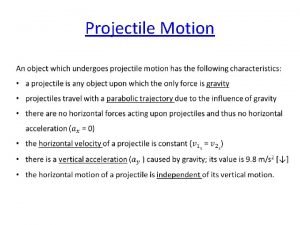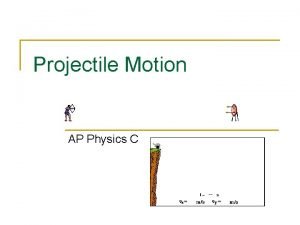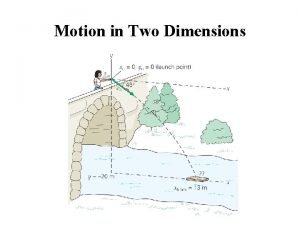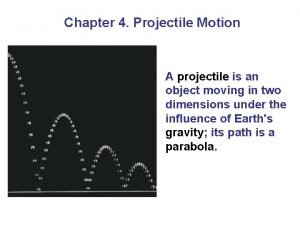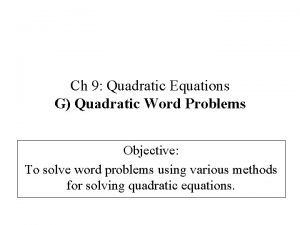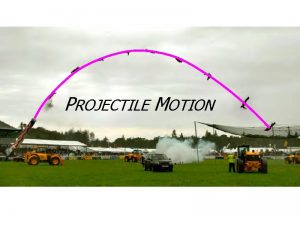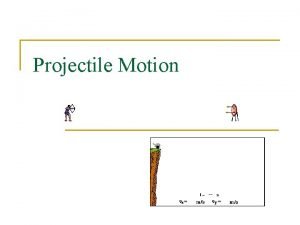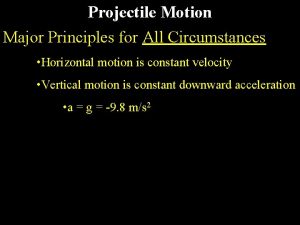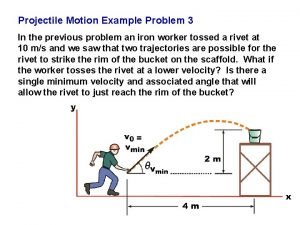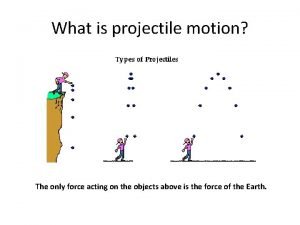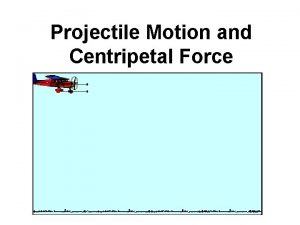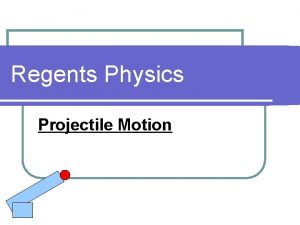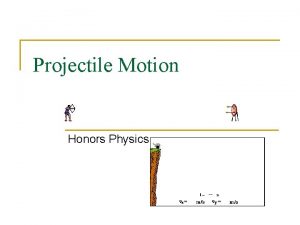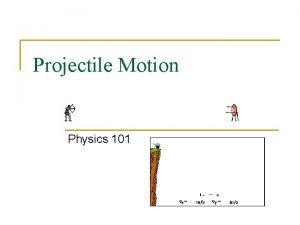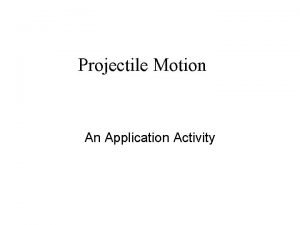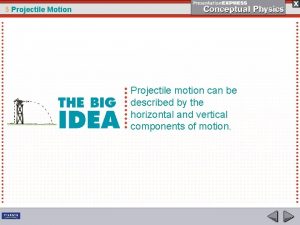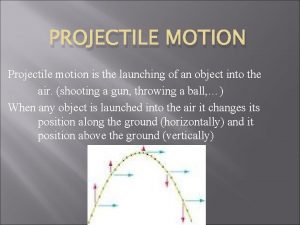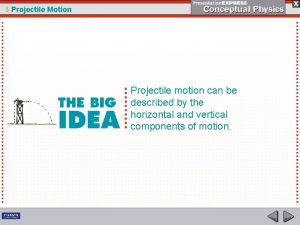Projectile Motion at an Angle Nathalie Ng Jennifer

























- Slides: 25

Projectile Motion at an Angle Nathalie Ng Jennifer Chen

Aim: How can we fully understand projectile motion at an angle? • Basically, we’re going to look at the basic components of projectile motion and how they relate to one another in order to make projectile motion at an angle seem easier than Mr. Wala says it is! • To understand projectile motion, let’s look at the motion of a ball thrown into the air and follow its trajectory (fancy word for “path of a projectile”). • Note: assume that there are no forces acting on the ball besides gravity.

• • When Nelo first throws the baseball, its instantaneous velocity is the greatest. This velocity has both a horizontal component (x) and a vertical component (y). Gravity immediately acts on the baseball as it leaves Nelo’s hand, pulling the ball down. This means that the vertical velocity will decrease as the ball gets higher until it reaches its maximum height, or peak. Then, the vertical component will increase as it falls in the direction of the gravitational pull until it reaches the original velocity’s magnitude. Note: The vertical velocity at the highest peak is ZERO because the ball is not moving up or down at that point. Unlike the vertical component of velocity, the horizontal component of velocity remains constant. It does not change because there at no factors or forces acting on it in the horizontal direction to produce an acceleration.

To simplify the idea of projectile motion, you should think of the horizontal and vertical components as separate.

How can we find the components of velocity? Horizontal Component vix = vi cosθ Vertical Component viy = vi sinθ Vi = Initial Velocity Θ = angle the projectile is launched Remember: SOH CAH TOA Imagine the horizontal and vertical components are on an x and y axis, respectively. In this case, the resultant of the two vectors would be the initial velocity and it would also act as the “hypotenuse” of the triangle that the vector resolution creates.

Note: If the angle is not given in the question (usually it is), you can find θ using the formula: θ = tan-1 (diy/dix)

• The largest vertical displacement is called the height and occurs at the peak of the trajectory. • The horizontal distance traveled, is called the range.

Calculating Maximum Height Part I: tup & ttotal When calculating the maximum height of a projectile, the formula for tup can be used to find the time passed for the projectile to reach the peak. tup = Viy/g Note: g = constant for gravitational acceleration = 9. 81 m/s 2 Since the maximum height is usually half of the full trajectory (assuming that the projectile lands at the same height as it was projected), tup is half the amount of the time of the full motion. ttotal = 2 tup

Calculating Maximum Height Part II: formula The formula used for height is: dymax = di + viytup – 1/2 gtup 2 Normally for regents questions, di is equal to zero. Because of this, the equation is simplified to the following and can be found in your reference table as well (Without the subscripts, of course. Don’t want to make it too easy for you!): dymax = viytup – 1/2 gtup 2 Remember: • viy is the initial vertical component of velocity • g (the universal gravitational constant) = 9. 81 m/s 2 • tup was found in the last slide! Fun Fact: A projectile will reach the highest height when it is launched at an angle of 90°!

Calculating Maximum Range Part I: Formula #1 The range accounts for the total amount of time the projectile is in the air. Therefore, use ttotal!!!! dx = vixttotal Note: This formula can be found on your reference table in its full form d = vit + ½ at 2. However, we know that there is no acceleration in the horizontal component (since we are assuming that there are no outside forces besides gravity involved) so it is not accounted for.

Calculating Maximum Range Part I: Formula #2 This formula is not on your reference table. However, it proves to be convenient in many cases (if you can memorize it!) dx = (vi 2 sin 2θ) / g Remember: dx = range vi = initial velocity θ = angle projectile is launched g = 9. 81 m/s 2 Fun Fact: A projectile has the greatest range when it is launched at 45°!

Formulas associated with Projectile Motion (found on back of Reference table!) Horizontal Component vix = vi cosθ vfx = vix = vx dx = vxt = (vi 2 sin 2θ) / g ax= 0 m/s 2 Vertical Component viy = vi sinθ vfy = viy - gt vfy 2 = viy 2 - 2 gdy dy = viyt - ½ gt 2 ay = g = 9. 81 m/s 2

Next will be some sample problems. Remember, the key to getting the correct answer for a physics question is to pluck out the variable given in the questions, then finding the formula that have those variables, and then plugging them in.

Sample Question #1 A cannonball is fired from ground level at an angle of 60° with the ground at a speed of 72 m/s. What are the vertical and horizontal components of the velocity at the time of launch?

Sample Question #1 Answer and Explanation Given vi = 72 m/s θ = 60° Remember the formula for finding the x and y components of velocity? Also: x component is horizontal and y component is vertical (think of a coordinate graph!) Missing: viy = ? ? vix = ? ? vix = vi cosθ vix = 72 m/s cos 60° vix = 36 m/s viy = vi sinθ viy = 72 m/s sin 60° viy = 62. 35 m/s

Sample Question #2 You kick a soccer ball at an angle of 40° above the ground with a velocity of 20 m/s. What is the maximum height the soccer ball will reach?

Sample Question #2 Answer and Explanation Given vi = 20 m/s θ = 40° For this question, you must find the initial vertical velocity in order to find the maximum height. Then plug it into a second equation noting that vfy = 0 m/s at maximum point. Missing: viy = ? ? ? dy = ? ? ? viy = vi sinθ viy = 20 m/s sin 40° viy = 12. 86 m/s vfy 2 = viy 2 – 2 gdy (0 m/s)2 = (12. 86 m/s)2 – 2(9. 81 m/s 2)dy -165. 38 m 2/s 2 = (-19. 62 m/s 2)dy 8. 43 m = dy

Sample Question #3 A cannonball is launched at ground level at an angle of 30° above the horizontal with an initial velocity of 26 m/s. How far does the cannonball travel horizontally before it reaches the ground?

Sample Question #3 Answer and Explanation Given vi = 26 m/s θ = 30° Missing: vix = ? ? ? viy = ? ? ? ttotal = ? ? ? dx = ? ? ? For this question, the vertical velocity must be found to find the total time. The horizontal velocity will need to be found to find the total range. viy = vi sinθ viy = 26 m/s sin 30° viy = 13 m/s ttotal = 2 tup = 2 (viy/g) ttotal = 2 (13 m/s /9. 81 m/s 2) ttotal = 2. 65 s vix = vi cosθ vix = 26 m/s cos 30° vix = 22. 56 m/s dx = vxt dx = (22. 56 m/s)(2. 65 s) dx = 60 m

Sample Question #3 Answer and Explanation #2 Given vi = 26 m/s θ = 30° Missing: dx = ? ? ? An easier way to do this problem is to use the other equation not specified on the reference table. dx = (vi 2 sin 2θ) / g dx = [(26 m/s)2 sin(2× 30°)] / 9. 81 m/s 2 dx = 60 m Which equation seems easier?

Sample Question #4 A quarterback throws a football to a stationary receiver 31. 5 m away from him. If the football is thrown at an initial angle of 40° to the ground, at what initial speed must the quarterback throw the ball for it to reach the receiver?

Sample Question #4 Answer and Explanation Given dx = 31. 5 m θ = 40° Missing: vi = ? ? ? You are given the range of the football and the angle it is thrown. Therefore to find the initial velocity needed for the football to reach the receiver, the easiest formula to use would be: dx = (vi 2 sin 2θ) / g 31. 5 m = [vi 2 sin(2× 40°)]/ 9. 81 m/s 2 309 m 2/s 2 = vi 2 sin 80° 313. 77 m 2/s 2 = vi 2 17. 7 m/s = vi

Sample Question #5 A golf ball is hit a horizontal distance of exactly 300 m. What is the maximum height the golf ball reaches in the air if it is launched at an angle of 25° to the ground?

Sample Question #5 Answer and Explanation Given dx = 300 m θ = 25° Missing: vi = ? ? ? viy = ? ? ? dy = ? ? ? You are given the range of the golf ball and the angle it is thrown and is looking for the height. This question will need a few more steps than the previous one. It will be easier to find height with viy. The initial vertical velocity can be found if the initial velocity is found first. The easiest formula to use would be: dx = (vi 2 sin 2θ) / g 300 m = [vi 2 sin(2× 25°)]/ 9. 81 m/s 2 2943 m 2/s 2 = vi 2 sin 50° 3841. 81 m 2/s 2 = vi 2 61. 98 m/s = vi Now that you have vi, you can find viy using the formula: viy = vi sinθ viy = 61. 98 m/s sin 25° viy = 26. 19 m/s With viy, dy can be determined using the following formula (remember that vfy is 0 m/s at maximum height!!!) : vfy 2 = viy 2 – 2 gdy (0 m/s)2 = (26. 19 m/s)2 – 2(9. 81 m/s 2)dy -686. 17 m 2/s 2 = (-19. 62 m/s 2)dy 34. 97 m = dy

The end
 Projectile motion simulator
Projectile motion simulator Ideal projectile motion equation
Ideal projectile motion equation What is c
What is c Projectile motion ball
Projectile motion ball Motion
Motion Fourteen line lyric poem
Fourteen line lyric poem The motion of a projectile is often studied in terms of
The motion of a projectile is often studied in terms of Projectile motion objectives
Projectile motion objectives Range formula physics
Range formula physics Projectile motion rules
Projectile motion rules Projectile motion
Projectile motion Projectile motion of javelin throw
Projectile motion of javelin throw Quadratic projectile word problems
Quadratic projectile word problems Omni projectile motion calculator
Omni projectile motion calculator Projectile motion examples
Projectile motion examples Examples of projectile motion in volleyball
Examples of projectile motion in volleyball Projectile motion example problems
Projectile motion example problems Ignoring air resistance
Ignoring air resistance Physics projectile motion formula
Physics projectile motion formula Does vertical velocity change in projectile motion
Does vertical velocity change in projectile motion Vy=voy-gt
Vy=voy-gt Projectile motion examples
Projectile motion examples Projectile motion with wind
Projectile motion with wind The only force acting on a projectile is
The only force acting on a projectile is Range of projectile formula
Range of projectile formula When no air resistance acts on a projectile
When no air resistance acts on a projectile
